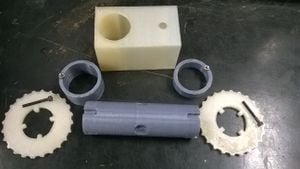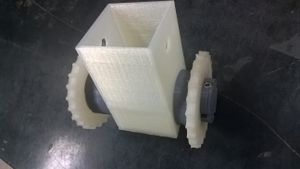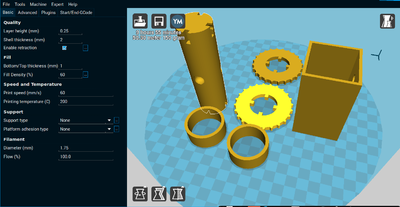Seed sowing device
Project developed by nagendra tanikella
Abstract
This equipment can be used to sow seeds with relative ease, compared to hand sowing. This product was designed for minimum number of parts and low weight.
A handle can be attached to the device, using an 8mm bolt (not shown in figures or attached currently) (A hollow tube will enable seeds to be dropped from within the handle.)
Calculations and measurements
Wheel diameter=60mm base, 64mm including teeth.
Shaft diameter=30mm
Number of seed holes on shaft = 3
Seed Hole maximum depth=7mm
Seed Hole maximum width=10mm
Length(along the shaft)=100mm
Height from ground = 90mm, 92mm including teeth.
Weight: 120g, including 3mm nuts and bolts
The seeds fall at equal intervals(approx;6.3cm in the dimensions given:2*3.14*(Radius of wheel)/(No. of holes on shaft) which can be modifying by changing the number of holes in the rotor part or by changing the wheel outer diameter.
The size of the holes can also be changed for allowing different sizes of seeds. The current hole was created by making a circle of radius 5mm, at an offset of 2mm inside the shaft. Padding the circle 10mm and then fillet by 4mm on both ends of the padded cylinder. This size is suitable for a pea seed.


Bill of Materials
- Filament
- 3mm bolts (30mm length) and nuts, 2pc
- A long handle, under 40mm diameter.
- 8mm bolt (60mm length) and nut.
Links to FreeCad files and Stl files can be found at thingiverse. http://www.thingiverse.com/thing:1181595
Tools needed for fabrication of the OSAT
- MOST Delta RepRap or similar RepRap 3-D printer
- Drill bits(3mm and 8mm) with drill gun
- Allen key/hex key
Skills and Knowledge Necessary to Make the OSAT
- FreeCad for modification and customization of the design
Technical Specifications and Assembly Instructions
Optional step: Download the FreeCad files. Modify the geometry. Changes can be made to "Pad for seed holes_to be cut" and "Seed holes to be cut" in the "rotor" part for modifying seed size. Save as Stl file.

Step1: Download the Stl files from Thingiverse.
Step2: Open the stl files in cura (2nos of wheel and spacer).All printed parts can be opened together and printed at once as shown in image.
Step3: Choose the printing specifications.
Step4: Save Gcode and print the parts.
Step5: Scrape the mating surfaces until all parts fit perfectly. The shaft should be able to rotate freely in the hole provided in the holder.
Step6: Assemble the parts as shown.
Step7: Attach a handle to the holder part using the 8mm bolt. (not shown)
Print time estimate: 10Hrs at 0.25mm layer height and maximum 60mm/s speed.
Assembly time estimate: 1-2 hours (for scraping off excess material)
| Assembly for seed sowing device |
|---|
Error in widget YouTube: Unable to load template 'wiki:YouTube' |
Common Problems and Solutions
- All components will require scraping off excess material to fit perfectly. The 3mm bolthead and nut will not fit directly in the bolthead hole. It has to be scraped significantly, depending on shape and size of the bolthead and nut.
Cost savings
Cost estimate:
Printed parts: 120gms, or 3$based on PLA cost of 20$/kg. 1$ for each additional rotor, (for different seed sizes).
Handle: Any PVC or spare pipe can be recycled for this.
Nuts and bolts: max 5$ if purchased separately. 1$ if purchased in bulk.
Total cost: 4$ to 12$
Commercially available similar products:
http://www.amazon.co.uk/gp/product/B001B8Y0H4?*Version*=1&*entries*=0 30 British pounds, or 45$. http://www.amazon.com/WOLF-Garten-Seed-Sower-1816000/dp/B000EJ0XBS/ref=cm_cr_pr_product_top?ie=UTF8 17$
Savings: 5$ to 41$. 30% to 91%.
Recommendations and future work
Commercially available seed drills have detachable "seed carriers", instead of being integrated in the shaft. This makes it easy to replace them for different seed sizes. A similar device would require more parts, leading to more printing time and cost, or less durability. It is not necessary for "single seed farming".
A lid may also be added to the seed holder to ensure the seeds don't fall